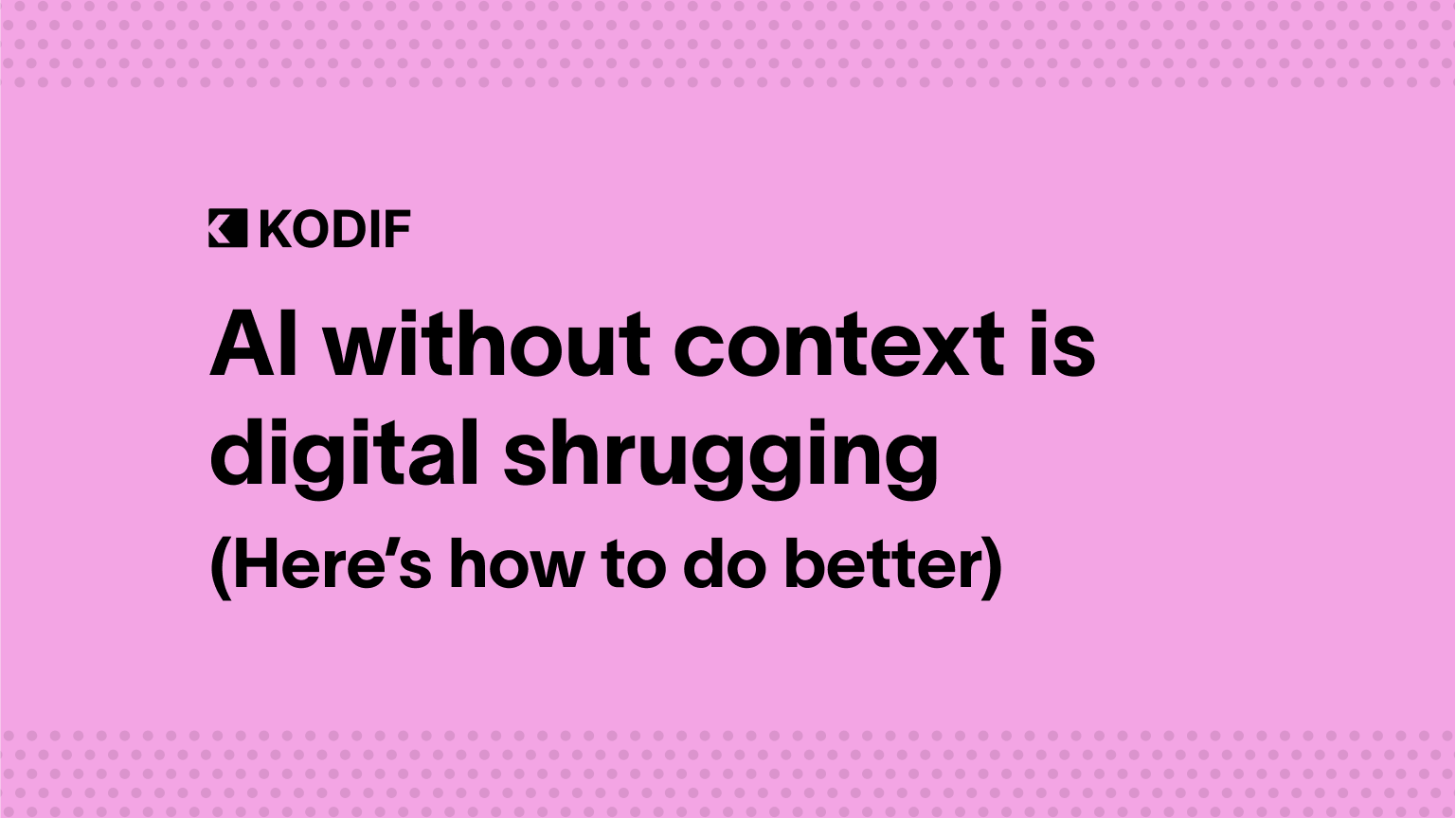Let’s play a game.
You’re a loyal customer. You’ve ordered five times from your favorite DTC brand and referred two friends.
Your last package was delayed, and now the replacement you requested hasn’t arrived.
You open a chat window and type:
“Hey, I reached out last week about a replacement for order #4567—still nothing. Can you check?”
And the bot replies:
“Hi there! What can I help you with today: Order status, returns, or general inquiries?”
You sigh, pick “Order status,” and brace for a loop of generic responses, broken tracking links, and no context whatsoever.
That’s where a lot of AI-powered support experiences begin, and unfortunately, where many of them end.
Technically, it’s automation. Practically? It’s customer abandonment dressed up in machine learning.
The problem with most AI customer service: all brains, no memory
There’s a reason so many AI implementations feel hollow: they’re built for automation, not understanding.
The vast majority of bots today are trained to do one thing: deflect. Get the ticket away from a human and solve the question just enough. Save money.
Deflection is not the same as resolution. And customers can tell the difference.
The missing piece? Context.
And not just “Hi, [First Name]” personalization. We’re talking about real, integrated, memory-backed context—about who the customer is, what they’ve bought, how they’re feeling, and what they’ve already been through.
Let’s talk about what personalization really means
Personalization in customer service is a bit like the word “natural” on food labels—used a lot, but rarely means anything.
Real personalization isn’t just using someone’s name or asking if they want help with “frequently asked questions.” It’s:
- Recognizing that someone is on their fourth support ticket this month
- Knowing they paused their subscription last cycle
- Noticing their last interaction ended in a refund
- Remembering they always ask for updates via SMS, not email
It’s not rocket science, it’s data. But the problem is that most support platforms (and most AI tools) don’t have access to that data.
Or if they do, they don’t know how to use it.
Which brings us to the part where we shamelessly talk about how KODIF handles this better.
What KODIF understands that most AI doesn’t
KODIF isn’t just a helpdesk plugin with a chatbot and a vaguely promising product tour. It’s a highly configurable AI platform that actually thinks about context as a core building block, not a feature add-on.
Here’s how that shows up in the real world:
AI Agents that actually know the customer
KODIF’s AI Agents don’t just fire off FAQ responses. They resolve issues—like “pause my subscription,” “update my shipping address,” “I think I got the wrong item”.
Thanks to native integrations with Shopify, Gorgias, and dozens of others, these agents are working with the full picture, not just isolated questions.
No asking the customers to provide details you already know or tone-deaf replies. Just actual help.
AI Manager: pattern recognition at scale
KODIF’s AI Analyst goes upstream, scanning conversations to find where personalization is missing—where customers are getting stuck, where bots are sounding robotic, where sentiment drops.
It doesn’t just flag trends—it notifies you on them in real time, and gives teams the data they need to fix flows, tune automations, and improve policies. Think of it as your internal churn radar, running 24/7.
AI Copilot: context for human agents, too
For cases that do need a human touch, KODIF doesn’t leave agents guessing.
The AI Copilot gives agents everything they need to personalize the conversation—customer history, tone guidance, likely resolution paths, and even smart suggestions for how to respond.
You’d be surprised how much better support gets when you remove guesswork.
How you can start adding context (even if you’re not using KODIF… yet)
You don’t need a total AI overhaul to start making your support more personal. Here are five things any CX team can start doing right now:
1. Audit your current flows for context gaps
Where are you asking customers for info you already have? Where are you treating subscribers like strangers? Start there.
2. Tag high-risk customer states
Paused subscriptions, recent refunds, multiple tickets in 30 days—these are churn signals. Flag them and respond differently.
3. Set tone guidelines based on history
Not every message needs to sound bubbly. If someone’s been frustrated, give your bot or agents the cue to sound human, not chipper.
4. Integrate your customer data (or at least centralize it)
If your support team has to check three tabs to know who they’re talking to, you have a context problem. Whether you use AI or not, build a single view of the customer.
5. Train your bots to say less, but mean more
No one wants a 200-word flow. Train your AI (or rewrite your macros) to reference what it knows, act fast, and sound like it knows what it’s doing.
TL;DR: stop building smarter bots, build more human ones.
AI doesn’t need to sound like a person. But it should at least know who it’s talking to.
Personalization and context are what separate the support experiences people love from the ones they rage-post about.
You can have the best LLM in the world, the smoothest flows, the cleanest UI—but if your system still doesn’t know that the person it’s talking to is a paying subscriber who’s contacted support three times this month?
You’ve automated nothing.
Want help fixing that? Start by fixing what your AI sees.
(And if you’re curious what that looks like with KODIF, you know where to find us.)









